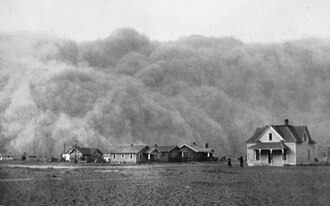Dust pneumonia
Clinical
Features
Variants
Images
Differential
Histology
Features
Variants
Images
Differential
Pathophysiology
Epidemiology
Associations
Workup
Labs
Imaging
Diagnostic criteria
Management
Treatment
Monitoring
Counseling
Other considerations
| Dust pneumonia | |
|---|---|
 | |
| A Dust Bowl-era dust storm in Texas (1935) | |
| Specialty | Pulmonology |
Dust pneumonia describes disorders caused by excessive exposure to dust storms, particularly during the Dust Bowl in the United States.[1] A form of pneumonia, dust pneumonia results when the lungs are filled with dust, inflaming the alveoli.[citation needed]
Symptoms of dust pneumonia include high fever, chest pain, difficulty in breathing, and coughing. With dust pneumonia, dust settles all the way into the alveoli of the lungs, stopping the cilia from moving and preventing the lungs from ever clearing themselves.[citation needed]
People who had dust pneumonia often died.[1] There are no official death rates published for the Great Plains in the 1930s. In 1935, dozens of people died in Kansas from dust pneumonia.[1] Red Cross volunteers made and distributed thousands of dust masks, although some farmers and other people in the affected areas refused to wear them.[1]
In popular culture
Dust pneumonia was featured in the work of several musicians and artists of the day, such as Woody Guthrie's song "Dust Pneumonia Blues".[2]
See also
- Silicosis – Form of occupational lung disease
- Dust storm
- Pneumonitis
References
- ↑ 1.0 1.1 1.2 1.3 Worster, Donald (2004-09-16). Dust Bowl: The Southern Plains in the 1930s. OUP USA. pp. 20–21. ISBN 9780195174885.
- ↑ Butler, Martin (2007). Voices of the down and out: The dust bowl migration and the great depression in the songs of Woody Guthrie. Heidelberg: Winter. p. 67. ISBN 9783825353674. OCLC 191828843.
Further reading
- Dermatology
- Articles with short description
- Medical condition not in Wikidata
- All articles with unsourced statements
- Articles with unsourced statements from November 2020
- Articles with invalid date parameter in template
- Pneumonia
- History of the American West
- Great Depression in the United States
- Environmental disasters in the United States
- Dust
